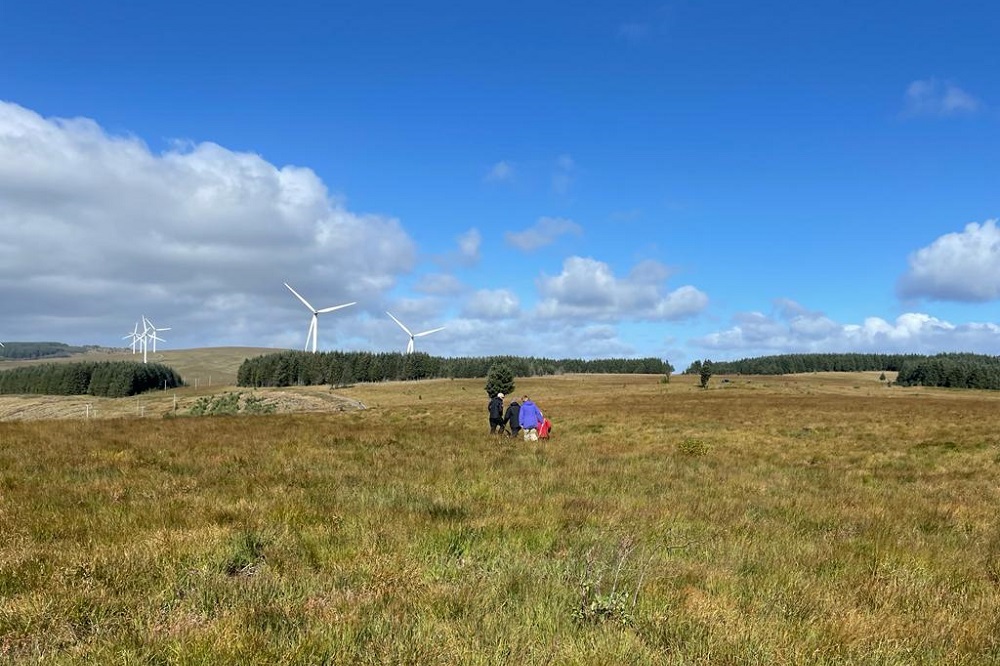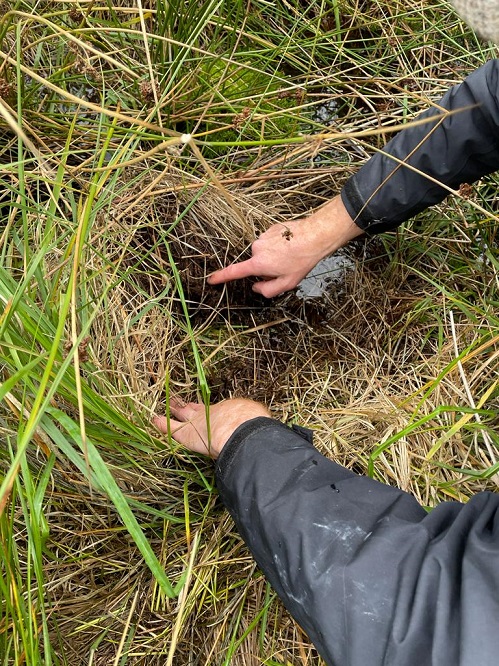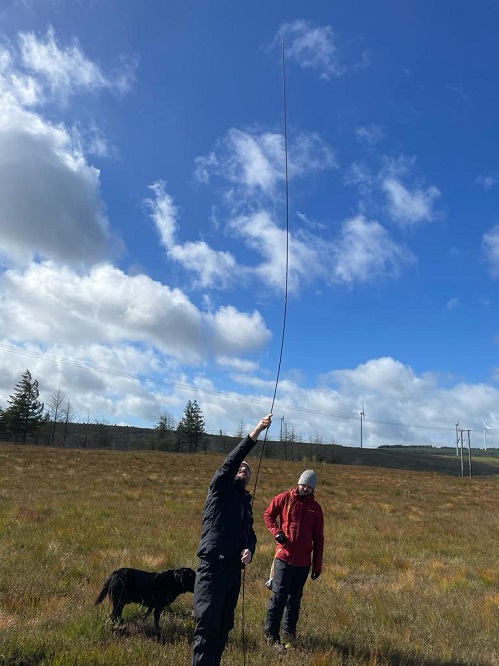Tawny Clark crosses space and time in search of poo, peat and the charismatic water vole

Tawny Clark
A tarmac sky descends on overworked windscreen wipers, as I traverse the snaking hairpins high above Aberdare. Up and up, until the blur of the road dissolves into a breath-taking, blustery mountain-scape.
In a heartbeat, blood pressure drops to ‘subliminal landscape’ low. Lateness anxiety dissipates enough for a toe to ease off the accelerator, just a touch, to absorb the sudden shift in scenery.
Longing to capture the moment fully, I’m tempted to swerve into innumerable laybys. To pause. But people are expecting me somewhere amid the weighty gloom, so for today at least I must sigh and move swiftly on.
With company met, and apologies given, I amass layers of clothing and don oversized coat, bobble hat, boots, and increasingly tight over-trousers.
Now prepared for whatever the wild and unpredictable terrain throws at me, I step into a forgotten world. The Lost Peatlands.
Being a long time since I scoured ditches in search of Kenneth Grahame’s beloved ‘Ratty’, I jumped at this chance to look for one of my favourite mammals – the charming and charismatic water vole.
Although, as a species that’s suffered catastrophic decline, my expectation is set an imperceptible notch above ‘give up and go home now’.
Tale of tragedy
Aside from the usual suspects – habitat loss and fragmentation – water voles have faced huge losses from intensified agriculture, water pollution, and modern watercourse management.
Theirs is a tale of tragedy. The most rapidly declining mammal species in Britain. Once found in nearly all watercourses on the mainland, research suggests water voles are now absent from 95% of their former range.
The adorable Ratty has yet another, dark and deadly, enemy. The North American mink.
Brought into the UK in the 1920’s for the commercial fur industry, mink escaped captivity (both accidentally and deliberately) and have contributed significantly to the decimation of native water vole populations.
This shy, vulnerable mammal’s only real defence strategy is to dive under the water and use a submerged ‘bolt-hole’ to escape into their bank-side burrow. But the invasive mink can easily follow.
There is no escape from this vicious, human-introduced predator for poor Ratty.
The tireless work of conservation organisations to control mink, alongside habitat restoration and species re-introductions, has been a major factor in water vole population recovery.
There are hopeful signs. But much work is still needed to right our historical and short-sighted wrongs.

Searching for poo
Spotting a water vole is understandably an incredibly rare occurrence.
If you’re lucky you may hear their characteristic ‘plop’ as one disappears into the water, but for most ecological surveys the methodology involves searching for field signs.
Today, we’re scouring the saturated vegetation that camouflages some precarious drainage ditches.
These are man-made scars which litter the peatland landscape and wreak havoc on carbon capture targets. But, as the Lost Peatlands team have been discovering, there’s much more to this landscape than meets the eye.
We’re looking for neatly manicured ‘gardens’, formed by water voles nibbling vegetation, and food stores, where they tidily stack fresh stems for later consumption.
Another sign – the obsession of field ecologist everywhere – we’re also searching for poo.
As finding any is practically impossible, when I do discover some chocolatey tic-tac droppings, I very nearly lose a leg into the steep-sided ditch and have to ‘style-it-out’.
We’re slightly cheating because the project ecologists have already spent the summer surveying ditches and know where to look. But still, it’s a real treat for me, and yet another wonderful facet to this extraordinary ecosystem.
Whether water voles are here because it’s a brilliant place to live, or, with mink everywhere else they have no other choice, I’m not sure. But they’re here, and – for now – the signs are good.
Peat probe
Having had our fill of parting reeds, we make our way over the peat. To reduce the risk of ankle-rolling, and quite possibly resulting from my failed attempt at styling-out my slip, Project Ecologist Joey, hands me a one metre length of peat probe.
These pencil-thin length’s – basically tent poles with threaded ends – help measure the depth of peat, but they’re also useful for testing the terrain ahead for hidden crevices and deep water.
Having been inducted into the Academy of Peat Probers this summer (not a real thing, sadly), it’s become quite an obsession.
Rather than utilising the probe as a walking aid, I’m instead preoccupied with wanting to continuously test the peat depth as I attempt to scramble through the rutted terrain and scoured-out ditches.
Although, with the team rapidly progressing, I’m frequently and frustratedly thwarted as I try to keep up.
Literally the moment Project Ecologist, Mike, stops to tell us about the Project’s peatland restoration work, the full length of the peat probe is in the ground.
It’s a feeling akin to the first sip of hot tea following a long winter walk. Ahhh.

Primal addiction
Previously when I’ve done it, we’ve been on shallow, degraded peat. Probes hadn’t reached far before meeting resistance. But here, the bog is faring better, it’s deeper than a metre. But how deep?
My initial euphoria gives way to frustration, unfulfillment. I’m not done.
I smile imploringly at Joey, who has a quiver of peat probes slung across his shoulder like a Gortex-clad Robin Hood. Taking pity on me, he whips another length from the bag and hands it over.
Carefully, but greedily, I screw it to the protruding metal tip of the first, then plunge it downwards into sodden depths – in what can only be described as a primal addiction.
As this too disappears, I wait impatiently for the next, before eagerly screwing on the fresh rod. Then another.
I’m almost too giddy to thread these subsequent one metre sections. How much deeper can it go?
Peat is thought to form at a rate of only one millimetre per year. I push again. Centuries, millennia, pass by. The weight of history utterly disregarded in my single-minded pursuit.
Finally, at 4.6 metres I meet resistance. Solid rock. 4,600 years of peat formation. A Neolithic beginning to the bog beneath my feet. Specialist, peat-forming sphagnum mosses were laying the foundations of this bog at the time of Stonehenge.
Talk over, Mike is keen to show us just how deep that is. Carefully, he pulls the probe from the ground until the towering pole sways high above us in the wind. It’s dwarfed by the turbines that litter the landscape, but an impressive sight, nevertheless.

Exotic plants
As we near the end of our outing, Joey points to a scarlet-hued eruption of carnivorous plants at our feet.
I consider making some half-amusing comment. ‘When is the sun due?’ But I’m beaten to my own terrible joke by something unnervingly auspicious.
A great gust whisks the sheet of impenetrable grey momentarily away and the sun inexplicably smiles down upon us. In an instant, the entire mountain is transformed. The breath steals from my lungs as the unloved, unappreciated ‘wet desert’ is revealed for what it truly is.
The uniform dullness now shimmers and glistens with diamonds. Individual droplets of rain are held in perfect spheres on Molinia blades and sphagnum tips. Dazzling embellishments that blanket the landscape like the sheen of a stormy sea.
The glittering spectacle of sundews at my feet sparkles like a trove of priceless rubies. Sticky and divine. The more I look, the more I see. Until there seems nothing but the cherry tentacles of these extraordinary, exotic plants; so inconspicuous before the flash-bulb gaze of the Sun set them ablaze.
These precious celebrities of the peatbog are undeniably deserving of the red-carpet attention our small assemblage affords them.
I’m reminded what a rare privilege it is to encounter this wonderous, hidden world. A world which exists so unassumingly above our fertile valleys and green, pleasant lands. Sublimity and serenity are drawn deep into my ribcage as my breath gradually returns.
As we make our way, rather forlornly, towards the human world below, I’m thankful for this rejuvenating visit to the Lost Peatlands, although, having been thoroughly battered by wind and rain, I’m most definitely ready for that first sip of tea.
More information on the Lost Peatland Project can be found here and you can follow the project on Facebook and Twitter
Support our Nation today
For the price of a cup of coffee a month you can help us create an independent, not-for-profit, national news service for the people of Wales, by the people of Wales.





Beautiful historic monuments to the Greens in the background.
I enjoyed reading that, nice one Tawny C !